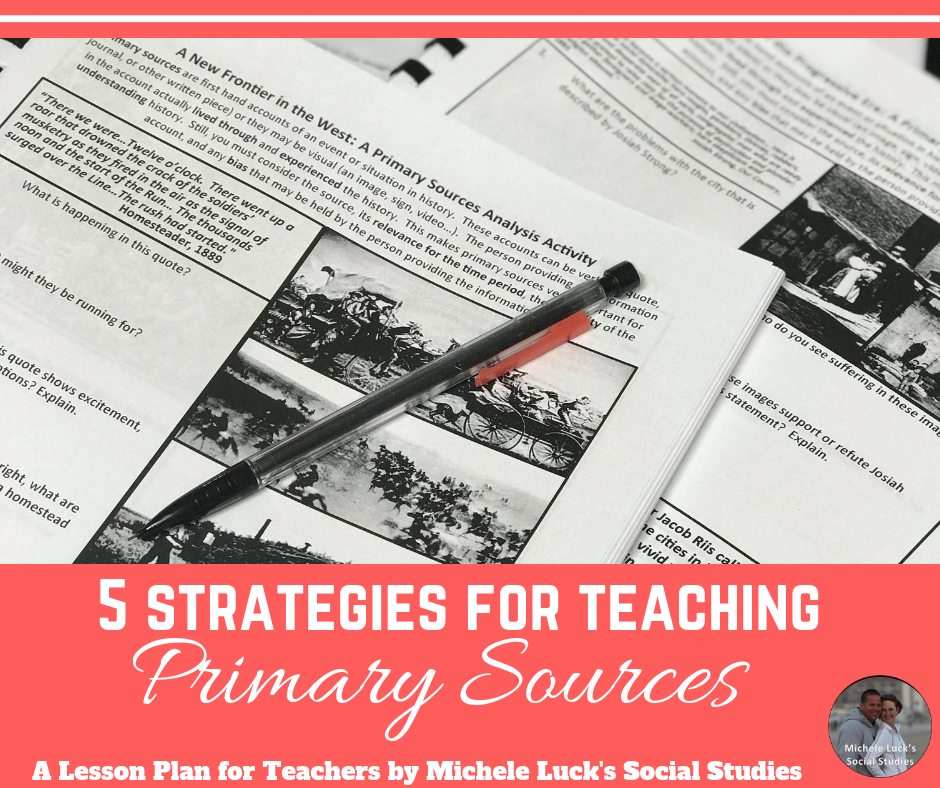
By using these raw materials, or primary sources, a teacher can present a plethora of historical information. However, students may be intimidated or confused by primary sources as they were sometimes written many decades ago, with lengthy verbiage, colloquial language, and advanced conceptual knowledge. Using these 5 strategies for teaching primary sources, it will be easier to break down the primary source at hand, analyze it, and then use the knowledge obtained to suit the lesson. By utilizing bellringers, primary source images, guided analysis questions, think-pair-share activities, and skills practice, your middle school and high school students are less likely to be intimidated by primary sources and more likely to grasp and retain the information within said documents.
1. Use bellringers or large assignments to quickly evaluate different themes or people. By using bellringers with this evaluation component, students can quickly assess the information at hand, pick out pertinent relationships (themes, people, comparisons, differences) and regurgitate the information in whichever method you’ve planned. Bellringers get students thinking quickly and without as much intimidation – students are more likely to approach the information unbiased and ready to absorb. By using primary sources in your bellringers, students get firsthand knowledge and experience with the document at hand.
2. Use images with spiral questioning format. Start with easy questions and gradually formulate harder inquiries. Throwing your students into primary source documents “head first” is a recipe for disaster. Instead, stairstepping the complexity of the documents as well as the questions and/or information obtained from the documents will ensure that your students aren’t quickly deterred from utilizing primary source documents. Your visual learners will also surely benefit from the use of images in conjunction with the wordy documents.

3. Use guided analysis questions to practice skills with multiple types of primary source documents. Once your students are little more familiar with primary source documents and how to utilize them for information, answering questions, and inquiring, they are more prepared to utilize more difficult documents. Using guided analysis questions will allow your students the opportunity to differentiate and analyze the information without feeling overwhelmed or unsure of where to start.
4. Work toward reading more in-depth and challenging documents with original wording to further develop skills. Once your students have mastered easier primary source documents, image analysis, and guided analysis questions, move into more in-depth documents. Students should have a better understanding of key points, meaning, and interpretation, and will be able to analyze difficult documents more easily. Forcing students to analyze original wording, completely with colloquial phrasing and above-grade-level text will encourage them to use context clues to grasp deeper meaning.
5. Do a think-pair-share activity with the lesson focus on content while practicing the skill of analysis. By using a think-pair-share activity, students will utilize their partner’s strengths to collaboratively analyze the primary source document at hand. This offers a fresh perspective, new interpretation, and deeper understanding of the topic at hand. Use other think-pair-share variations for variety in the classroom.
By using these 5 strategies for teaching primary sources in the classroom, your middle school and high school students will grasp a deeper understanding of these historic documents, develop methods and skills for easy analysis, and learn to utilize these raw documents in their regular Social Studies study.
With over 84 pages of primary source documents and activities, this United States Complete Primary Source Analysis Bundle Set is perfect for your middle school and high school US History lesson plans. Using these primary source analysis activities, students are sure to master these 5 strategies for understanding and analyzing primary sources in the classroom.
 Happy Teaching!
Happy Teaching!

Very nice information, every teacher has to follow it. It will help teachers in teaching students. These strategies are very useful for teachers.
School in Sanganer Jaipur